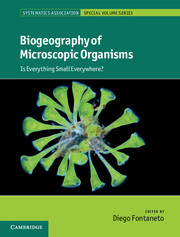Book contents
- Frontmatter
- Contents
- List of contributors
- Preface
- Part I Theoretical framework
- Part II Prokaryotes
- Part III Unicellular eukaryotes
- Part IV Pluricellular eukaryotes
- 9 Coalescent analyses reveal contrasting patterns of intercontinental gene flow in arctic-alpine and boreal-temperate fungi
- 10 Biogeography and phylogeography of lichen fungi and their photobionts
- 11 Biogeography of mosses and allies: does size matter?
- 12 Dispersal limitation or habitat quality – what shapes the distribution ranges of ferns?
- 13 Ubiquity of microscopic animals? Evidence from the morphological approach in species identification
- 14 Molecular approach to micrometazoans. Are they here, there and everywhere?
- Part V Processes
- Index
- Systematics Association Publications
- Systematics Association Special Volumes
- Plate section
- References
13 - Ubiquity of microscopic animals? Evidence from the morphological approach in species identification
from Part IV - Pluricellular eukaryotes
Published online by Cambridge University Press: 05 August 2012
- Frontmatter
- Contents
- List of contributors
- Preface
- Part I Theoretical framework
- Part II Prokaryotes
- Part III Unicellular eukaryotes
- Part IV Pluricellular eukaryotes
- 9 Coalescent analyses reveal contrasting patterns of intercontinental gene flow in arctic-alpine and boreal-temperate fungi
- 10 Biogeography and phylogeography of lichen fungi and their photobionts
- 11 Biogeography of mosses and allies: does size matter?
- 12 Dispersal limitation or habitat quality – what shapes the distribution ranges of ferns?
- 13 Ubiquity of microscopic animals? Evidence from the morphological approach in species identification
- 14 Molecular approach to micrometazoans. Are they here, there and everywhere?
- Part V Processes
- Index
- Systematics Association Publications
- Systematics Association Special Volumes
- Plate section
- References
Summary
Introduction
Zoologists always hope to find unusual and interesting new animals in exotic places. Over the last few centuries, scientific expeditions in remote places outside Europe and North America have indeed discovered new species and even higher taxa of vertebrates, insects and other macroscopic animals, completely different from the ones previously known in the home country. In contrast, scientists working on microscopic animals, looking at samples from remote areas, have often found organisms that could be ascribed to familiar species. Microscopic animals have thus been considered not interesting in biogeography, as their distribution may not be limited by geography.
Are microscopic animals really widely distributed? Is their cosmopolitanism an actual biological property or only a common misconception based on false assumptions and unreliable evidence? Is the scenario more complex than the claimed clear-cut difference between micro- and macroscopic animals? This chapter will review all the faunistic knowledge gathered so far on the global distribution of free-living microscopic animals smaller than 2 mm (gastrotrichs, rotifers, tardigrades, micrognathozoans, cycliophorans, loriciferans, kinorhynchs and gnathostomulids). Moreover, we will deal with microscopic free-living species in other groups of animals such as nematodes and flatworms, which have both micro- and macroscopic species. The focus will be on species identification from traditional taxonomy based on morphology, whereas Chapter 14 will deal with more recent evidence gathered from analyses on molecular phylogeny and phylogeography from the same groups.
- Type
- Chapter
- Information
- Biogeography of Microscopic OrganismsIs Everything Small Everywhere?, pp. 244 - 283Publisher: Cambridge University PressPrint publication year: 2011
References
- 36
- Cited by



